Preparation Technique and Properties of Nano-TiO2 Photocatalytic Coatings for Asphalt Pavement
Abstract
:Featured Application
Abstract
1. Introduction
2. Materials and Experimental Preparation
2.1. Selection of Nano-TiO2 Crystals
2.2. Materials for TiO2 Photocatalytic Coating
- Dispersants: Two kinds of dispersants, S-5040 and sodium hexametaphosphate (SHP), were used. The detailed technical indicators, which were provided by the manufacturer Shandong Huali Bio-tech Co., Ltd. (Zibo, China), are shown in Table 3.
- Emulsifiers: Three kinds of representative emulsifiers—rapid-setting cationic emulsifier SY-QCE, medium-setting cationic emulsifier KZW-802, and slow-setting cationic emulsifier SY-CME—were chosen. The technical indicators, which were provided by the manufacturer Jiangsu Xinyue Asphalt Co., Ltd. (Zhenjiang, China), are shown in Table 4.
- Asphalt: A kind of 70# penetration “A” grade asphalt binder was selected (Shell (China) Limited). The main physical properties of the asphalt binder were tested following the Chinese Standard Test Methods of Bitumen and Bituminous Mixtures for Highway Engineering (JTG E20-2011) [24] and met the requirements in the Chinese Specifications for Construction of Highway Asphalt Pavements (JTG F40-2004) [25], as shown in Table 5.
- In addition, CaCl2 (Wuhan Fude Chemical Co., Ltd., Wuhan, China) and hydrochloric acid (Wuhan Fude Chemical Co., Ltd., Wuhan, China) were selected as additives.
2.3. Asphalt Mixture for Base Sample
2.4. Exhaust Gas Degradation Test Device and Evaluation Indexes
2.4.1. Exhaust Gas Test Devices and Test Steps
- The nano-TiO2 photocatalytic coating was prepared (the detailed procedures are shown in Section 3.2).
- The coating was then sprayed on the surface of the slab specimen according to the designated amount. The emulsified asphalt coating containing a certain amount of nano-TiO2 was uniformly painted onto the slab sample with a brush, as shown in Figure 3.
- The coating was put in a dry and ventilated place for more than 24 h to ensure that the coating was completely dry. After that, the slab was put into the degradation reaction chamber. The exhaust gas analyzer was turned on and a certain concentration of exhaust gas was injected into the degradation reaction chamber.
- The UV lamps were turned on, along with a small fan, and the voltage of the UV lamps was adjusted such that the UV irradiance could reach the average outdoor UV irradiance of 26.7 W/m2.
- The gas concentration in the degradation reaction chamber was recorded every 10 min. The test time was set to 90 min for every specimen. At least three specimens were prepared for each nano-TiO2 content or spraying amount of photocatalytic coating.
2.4.2. Evaluation Indexes
3. Preparation of the Nano-TiO2 Photocatalytic Coating
3.1. Materials Selection
3.1.1. Dispersant
3.1.2. Emulsifier
3.2. Preparation Process
- A total of 2 g CaCl2 was added into 382 g of high purity water. Then, the water was heated and stirred to fully dissolve the CaCl2.
- A total of 20 g of SY-CME was added into the solution and dissolved thoroughly.
- A total of 16 g of dispersant S-5040 was added into the solution and stirred thoroughly, then 80 g of nano-TiO2 was added and stirred for 15 min. After that, the soap solution was kept at a temperature of 70 °C for later use.
3.3. Performance of the Nano-TiO2 Photocatalytic Coating
- The color of the photocatalytic coating emulsion with different nano-TiO2 contents was brown, which indicated that the emulsification effect was better.
- With the increase of the amount of nano-TiO2, the standard viscosity of photocatalytic coatings decreased, indicating that the photocatalytic coatings gradually became viscous. The main reason was that nano-TiO2 had a good adsorption capacity to asphalt because of its small particle size and large specific surface area. Although the coatings became viscous with increasing nano-TiO2 content, all of the photocatalytic coatings met the technical requirements of the standard viscosity of PC-2 (sprinkling cationic slow-setting emulsified asphalt) in the Chinese Technical Specifications for Construction of Highway Asphalt Pavements (JTG F40-2004) [25].
- With the increase of the nano-TiO2 content, the storage stability of the photocatalytic coating became worse. This is mainly due to the increase of the content of nano-TiO2, which made the nano-TiO2 particles prone to agglomerate, finally resulting in the reduction of storage stability of the photocatalytic coatings.
- The abrasion resistance of nano-TiO2 photocatalytic coating was evaluated using the wet track abrasion loss test. The test results showed that the wet track abrasion loss value of all the asphalt mixture with nano-TiO2 photocatalytic coating after the specimen being immersed into water for 1 h met the technical requirements of the Chinese Technical Specifications for Construction of Highway Asphalt Pavements (JTG F40-2004) [25] (no more than 540 g/m2). It showed that the nano-TiO2 photocatalytic coating had good abrasion resistance.
4. Evaluation of Exhaust Gas Degradation Effect
4.1. Effects of the Nano-TiO2 Content on Exhaust Gas Degradation
4.2. Effects of the Spraying Amount on Exhaust Gas Degradation
5. Pavement Performance Evaluation
5.1. Skid Resistance
5.2. Water Permeability
6. Conclusions
Author Contributions
Funding
Conflicts of Interest
References
- Zhang, W.G.; Zou, Y.X.; Sun, G.Q. Research on photocatalytic performance influencing factors of asphalt mixture adulterated with TiO2. J. Wuhan Univ. Technol. 2012, 34, 38–41. [Google Scholar]
- Li, L.P.; Li, W.B.; Hu, B.Y.; Yu, J.; Ye, F. Photocatalytic Degradation of Tail Gas Pavement Material by Nano-TiO2 Epoxy Resin. Sci. Technol. Eng. 2017, 17, 328–333. [Google Scholar]
- Poon, C.S.; Cheung, E. No Removal Efficiency of Photoca-Talytic Paving Blocks Perpared with Recycled Materials. Constr. Build. Mater. 2007, 21, 1746–1753. [Google Scholar] [CrossRef]
- Hassan, M.; Mohammad, L.N.; Dylla, H.; Asadi, S.; Cooper, S., III. Laboratory and Field Evaluation of Sustainable Photocatalytic Asphalt Pavements. J. Assoc. Asphalt Paving Technol. 2012, 81, 1–20. [Google Scholar]
- Binas, V.; Venieri, D.; Kotzias, D.; Kiriakidis, G. Modified TiO2 based photocatalysts for improved air and health quality. J. Mater. 2017, 13, 3–16. [Google Scholar]
- Mikaeili, F.; Topcu, S.; Jodhani, G.; Gouma, P.I. Flame-Sprayed Pure and Ce-Doped TiO2 Photocatalysts. Catalysts 2018, 8, 342. [Google Scholar] [CrossRef]
- Petronella, F.; Truppi, A.; Ingrosso, C.; Placido, T.; Striccoli, M.; Curri, M.L.; Agostiano, A.; Comparelli, R. Nanocomposite materials for photocatalytic degradation of pollutants. Catal. Today 2017, 281, 85–100. [Google Scholar] [CrossRef]
- Truppi, A.; Petronella, F.; Placido, T.; Striccoli, M.; Agostiano, A.; Curri, M.; Comparelli, R. Visible-Light-Active TiO2-Based Hybrid Nanocatalysts for Environmental Applications. Catalysts 2017, 7, 100. [Google Scholar] [CrossRef]
- Zhao, Y.; Ma, L.; Chang, W.K.; Huang, Z.H.D.; Feng, X.G.; Qi, X.X.; Li, Z.H. Efficient photocatalytic degradation of gaseous N, N-dimethylformamide in tannery waste gas using doubly open-ended Ag/TiO2 nanotube array membranes. Appl. Surface Sci. 2018, 444, 610–620. [Google Scholar] [CrossRef]
- Deng, A.Q.; Zhu, Y.F.; Gou, X.; Zhou, L.; Jiang, Q.S. Synthesis of Various TiO2 Micro-/Nano-Structures and Their Photocatalytic Performance. Materials 2018, 11, 995. [Google Scholar] [CrossRef] [PubMed]
- Ali, H.M.; Babar, H.; Shah, T.R.; Sajid, M.U.; Qasim, M.A.; Javed, S. Preparation Techniques of TiO2 Nanofluids and Challenges: A Review. Appl. Sci. 2018, 8, 587. [Google Scholar]
- Baldauf, R.; Thoma, E.; Hays, M.; Shores, R.; Kinsey, J.; Gullett, B.; Kimbrough, S.; Isakov, V.; Long, T.; Snow, R.; et al. Traffic and meteorological impacts on near-road air quality: Summary of methods and trends from the Raleigh near-road study. J. Air Waste Manag. Assoc. 2008, 58, 865–878. [Google Scholar] [CrossRef] [PubMed]
- Thomas, E.D.; Shores, R.C.; Isakov, V.; Baldauf, R.W. Characterization of near-road pollutant gradients using path-integrated optical remote sensing. J. Air Waste Manag. Assoc. 2008, 58, 879–890. [Google Scholar] [CrossRef]
- Venturini, L.; Bacchi, M. Research, design, and development of a photocatalytic asphalt pavement. In Proceedings of the 2nd International Conference on Environmentally Friendly Roads, Warsaw, Poland, 15–16 October 2009; pp. 1–16. [Google Scholar]
- Chen, M.; Liu, Y.H. NOx removal from vehicle emissions by functionality surface of asphalt road. J. Hazard. Mater. 2010, 174, 375–379. [Google Scholar] [CrossRef] [PubMed]
- Xu, H.M.; Liu, L.P.; Sun, L.J.; Li, J.F. The application of Nanometer Titanium dioxide in road engineering. Highw. Eng. 2011, 36, 189–191. [Google Scholar]
- Wang, X.X. Degrading Performance Research of OGFC Pavement on Vehicle Exhaust. Master’s Thesis, Beijing University of Civil Engineering and Architecture, Beijing, China, 2015. [Google Scholar]
- Tan, Y.Q.; Li, L.K.; Wei, P.; Sun, Z.H. Application performance evaluation on material of automobile exhaust degradation in asphalt pavement. China J. Highw. Transp. 2010, 23, 21–27. [Google Scholar]
- Hassan, M.; Mohammad, L.N.; Asadi, S.; Dylla, H.; Cooper, S., III. Sustainable Photocatalytic Asphalt Pavements for Mitigation of Nitrogen Oxide and Sulfur Dioxide Vehicle Emissions. J. Mater. Civ. Eng. 2013, 25, 365–371. [Google Scholar] [CrossRef]
- Hassan, M.M.; Dylla, H.; Asadi, S.; Mohammad, L.N.; Cooper, S. Mohammad; Samuel Cooper. Laboratory. Evaluation of Environmental Performance of Photocatalytic Titanium Dioxide Warm-Mix Asphalt Pavements. J. Mater. Civ. Eng. 2012, 24, 599–605. [Google Scholar] [CrossRef]
- Dylla, H.; Hassan, M.M.; Schmitt, M.; Rupnow, T.; Mohammad, L.N.; Wright, E. Effects of roadway contaminants on titanium dioxide photodegradation of nitrogen oxides. Transp. Res. Rec. 2011, 2240, 22–29. [Google Scholar] [CrossRef]
- Osborn, D.; Hassan, M.; Asadi, S.; White, J.R. Durability Quantification of TiO2 Surface Coating on Concrete and Asphalt Pavements. J. Mater. Civ. Eng. 2014, 26, 331–337. [Google Scholar] [CrossRef]
- Cros, C.J.; Terpeluk, A.L.; Burris, L.E.; Crain, N.E.; Corsi, R.L.; Juenger, M.C. Effect of weathering and traffic exposure on removal of nitrogen oxides by photocatalytic coatings on roadside concrete structures. Mater. Struct. 2014, 48, 3159–3171. [Google Scholar] [CrossRef]
- The Chinese Standard Test Methods of Bitumen and Bituminous Mixtures for Highway Engineering; JTG E20-2011; Renmin Communication Press: Beijing, China, 2011.
- The Chinese Technical Specifications for Construction of Highway Asphalt Pavements; JTG F40-2004; Renmin Communication Press: Beijing, China, 2004.
- The Chinese Test Methods of Aggregate for Highway Engineering; JTG E42-2005; Renmin Communication Press: Beijing, China, 2005.
- The Chinese Field Test Methods of Subgrade and Pavement for Highway Engineering; JTG E60-2008; Renmin Communication Press: Beijing, China, 2008.
- The Chinese Specifications for Design of Highway Asphalt Pavement; JTG D50-2006; Renmin Communication Press: Beijing, China, 2006.


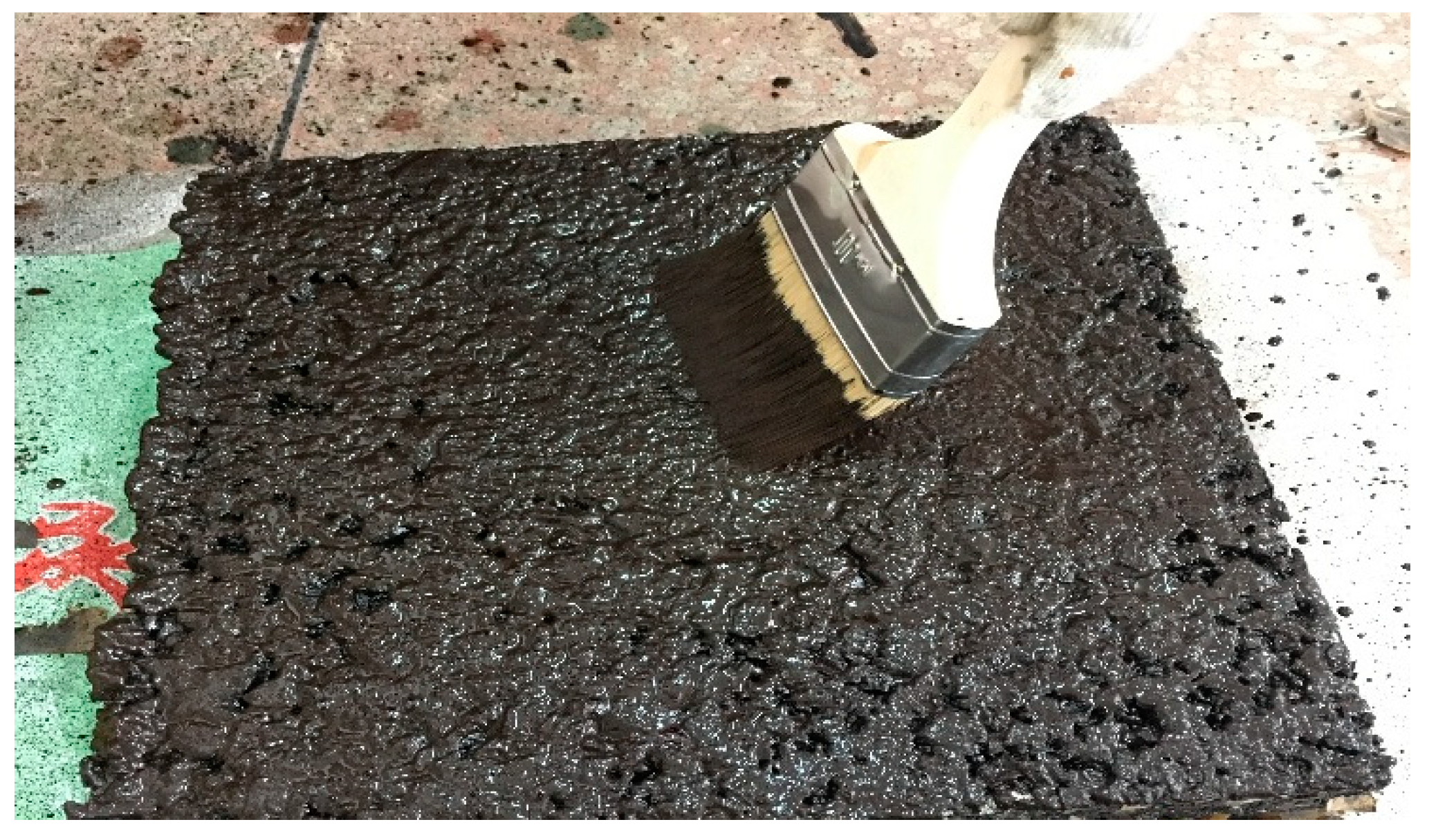
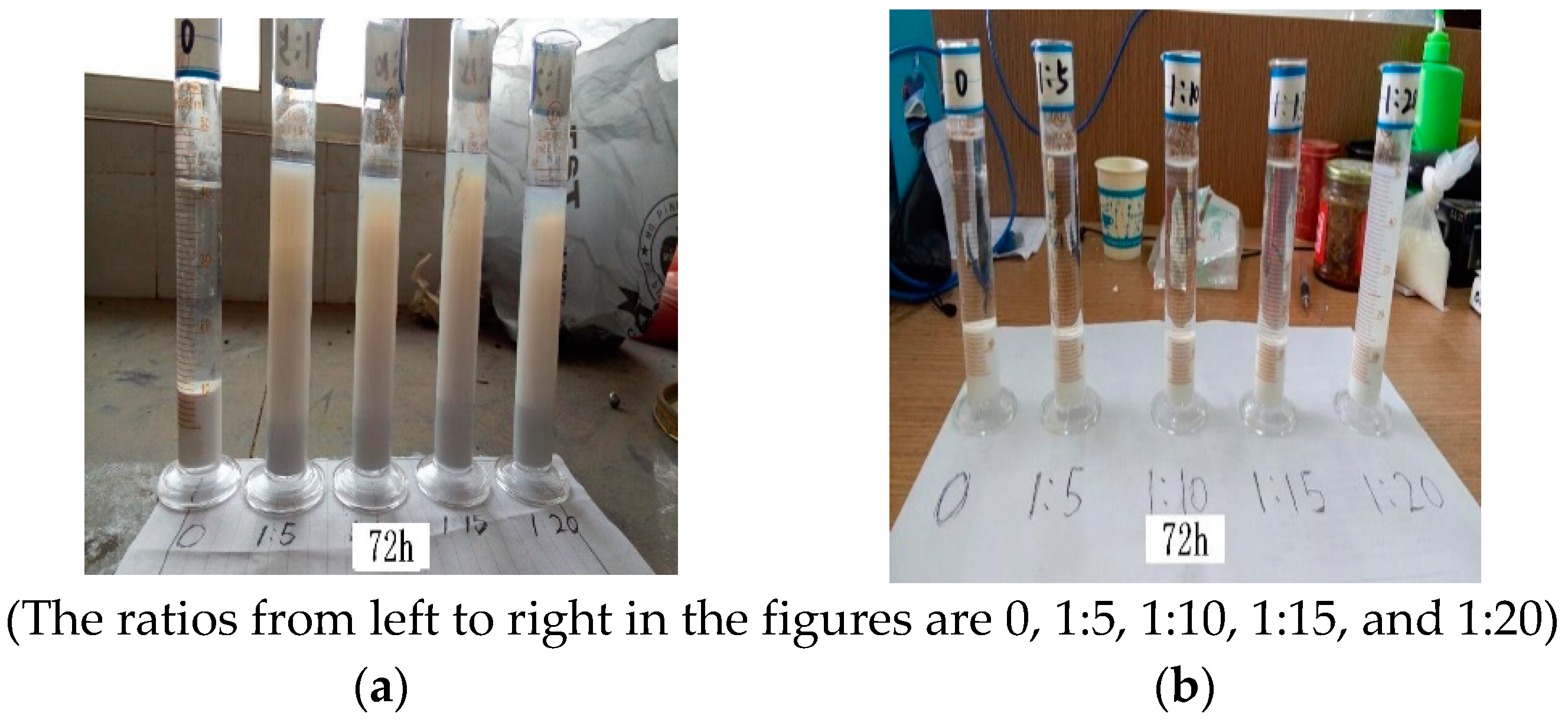
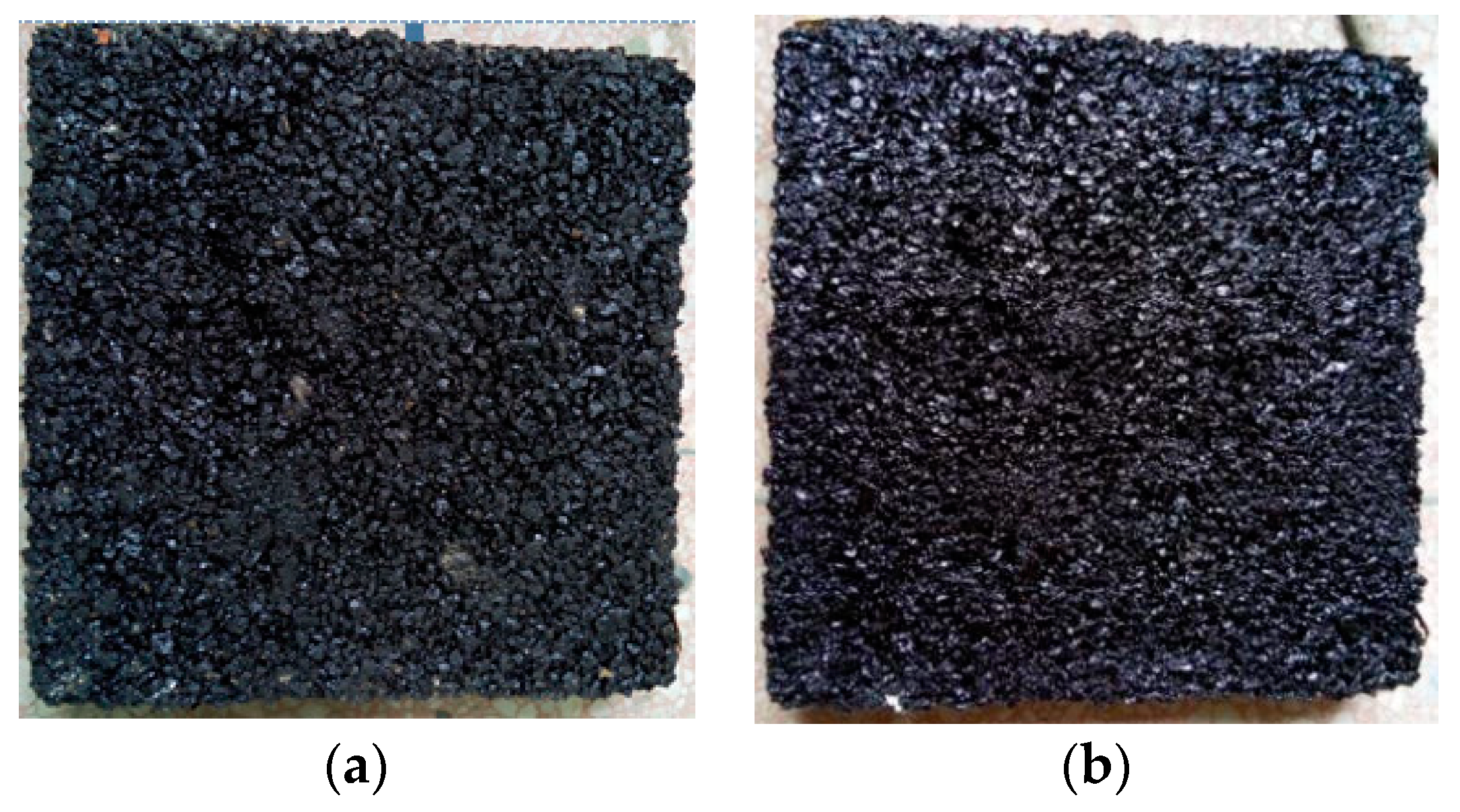
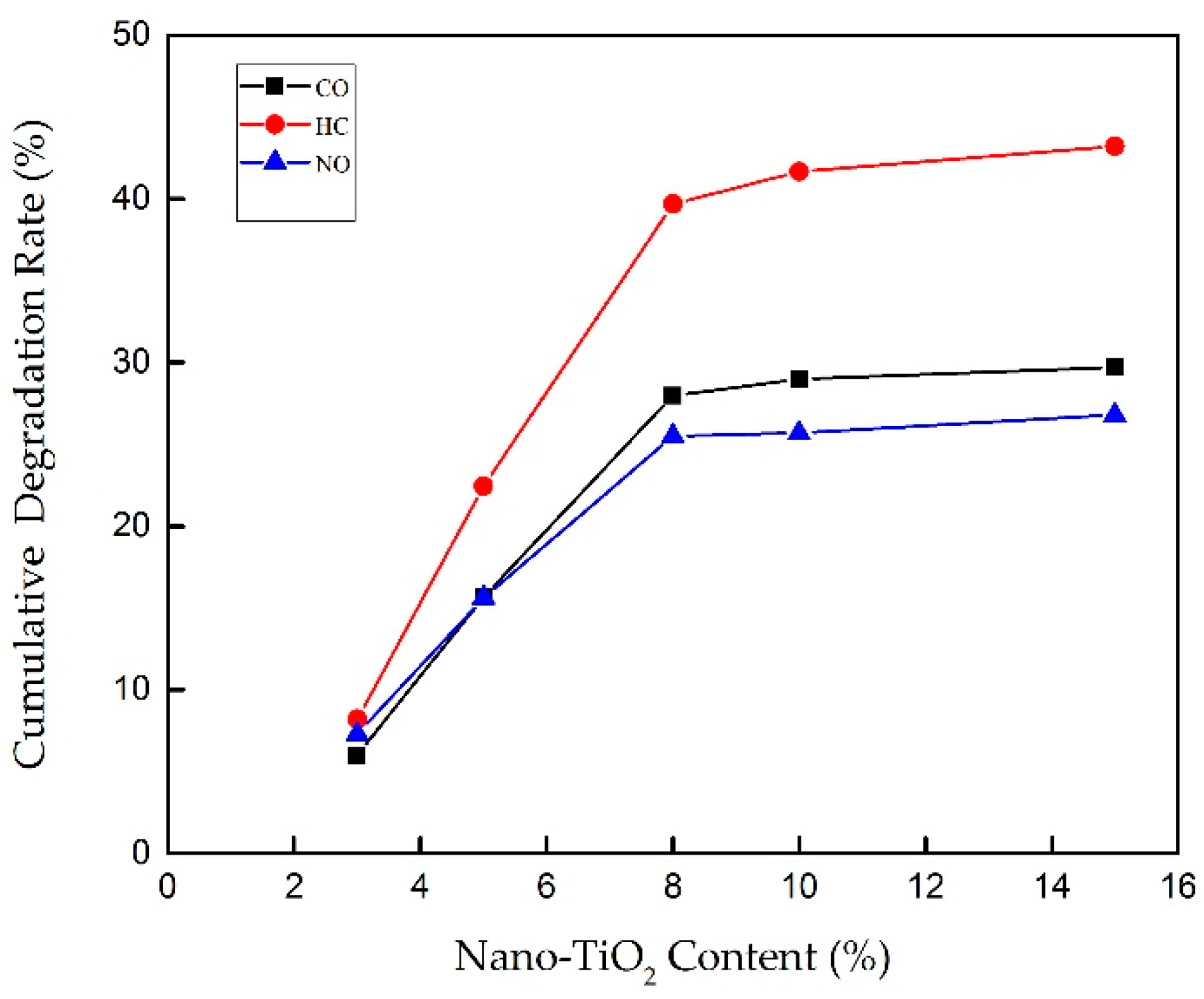
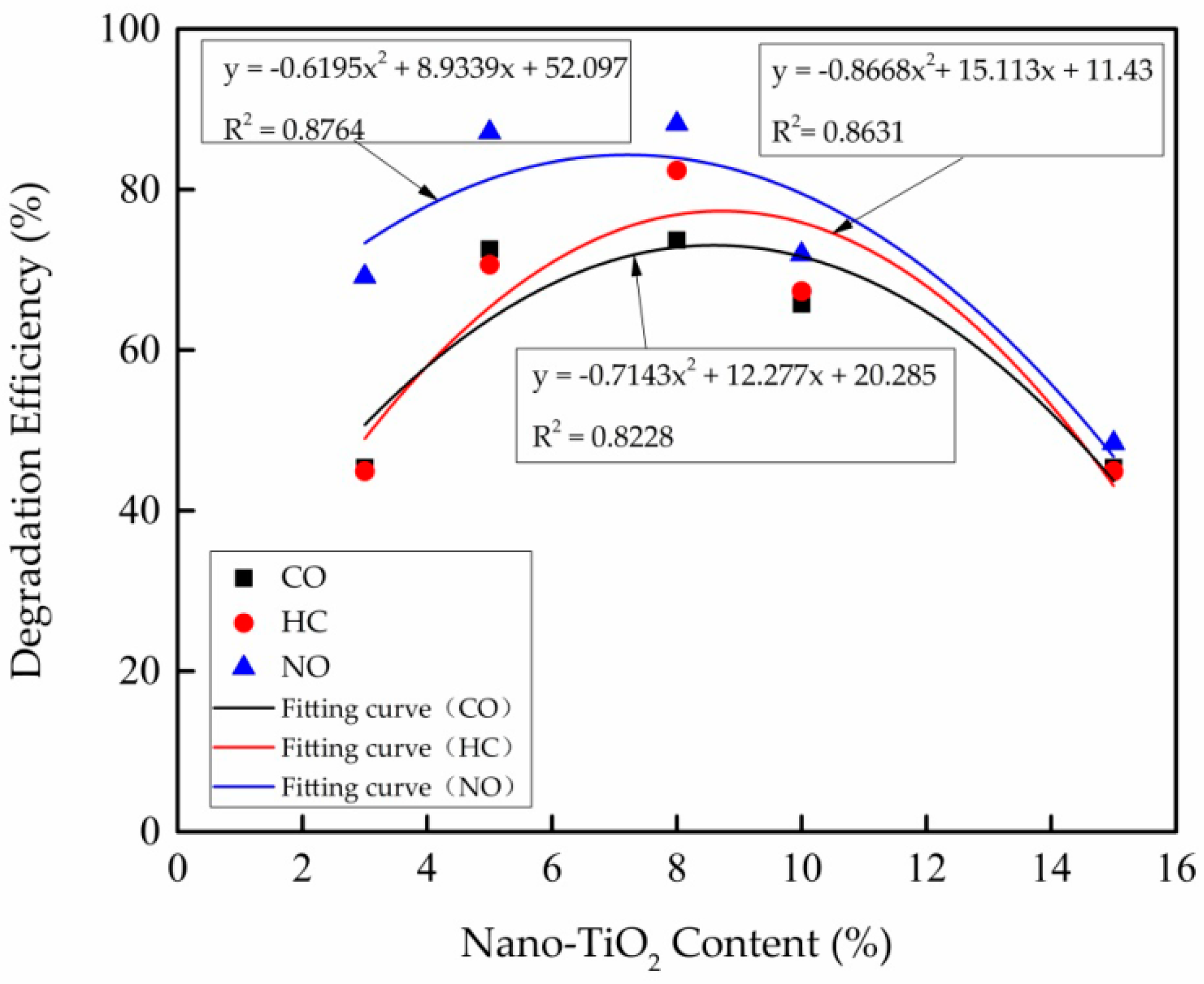

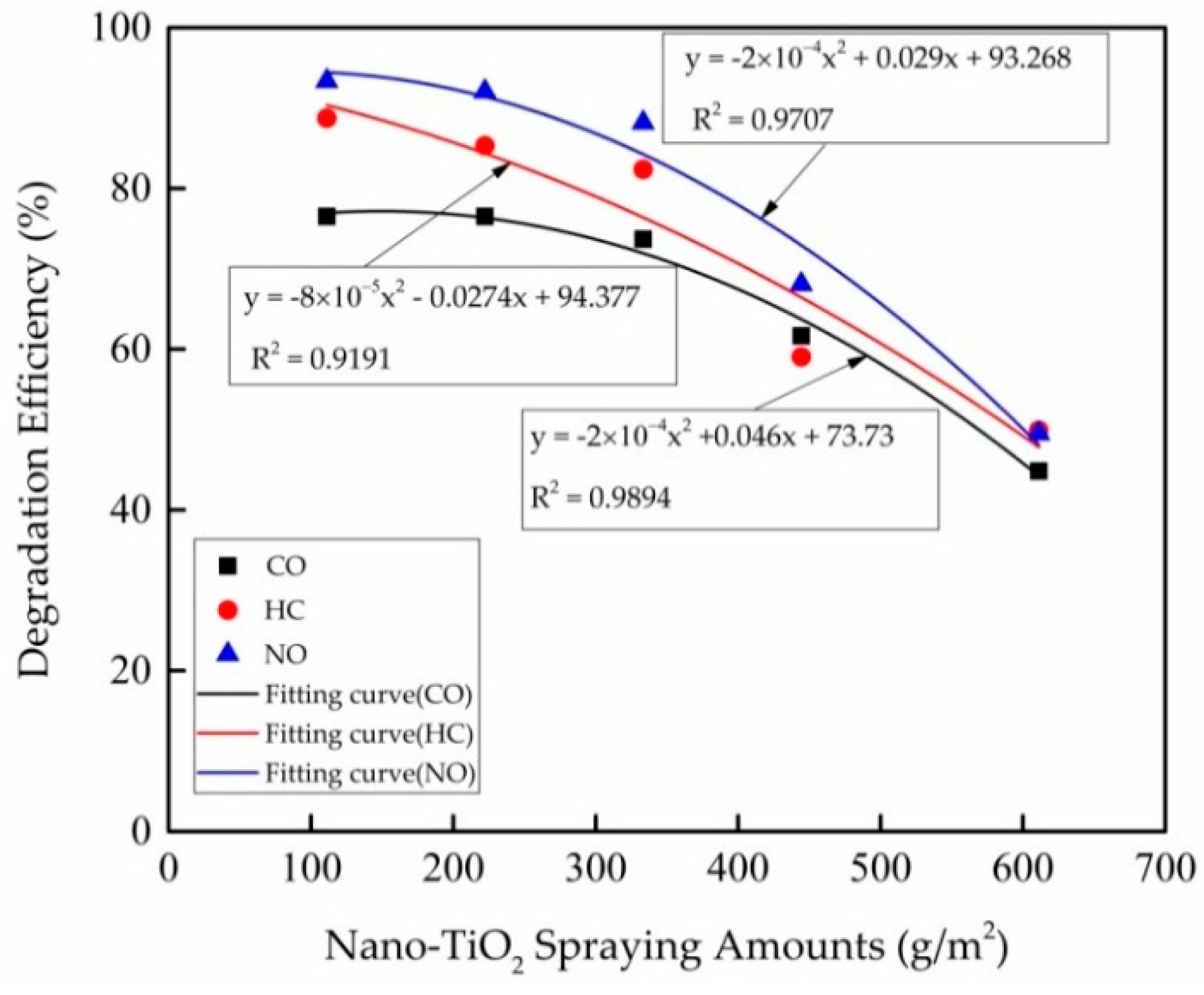
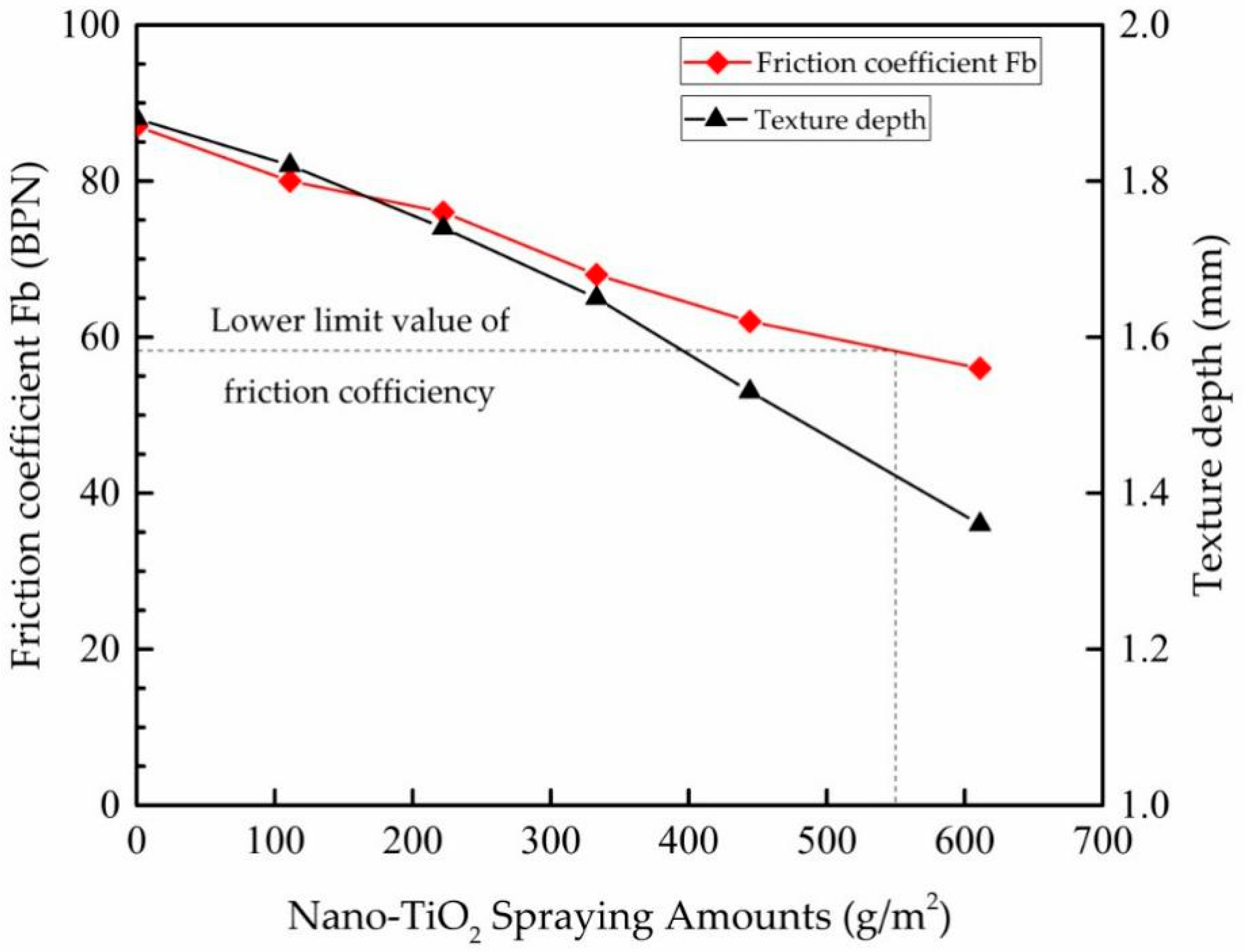
| Crystal Type | Relative Density | Crystal System | The Lattice Constant (nm) | Ti–O Distance (nm) | The Forbidden Band Width (eV) | |
|---|---|---|---|---|---|---|
| a | c | |||||
| anatase | 3.84 | tetragona | 5.27 | 9.37 | 0.195 | 3.2 |
| rutile | 4.26 | tetragona | 9.05 | 5.80 | 0.199 | 3.0 |
| brookite | 4.17 | lorthorhombic | _ | _ | _ | _ |
| Appearance | Specific Surface Area (m2/g) | pH | Particle Size (nm) | Loss on Drying (%) | Loss on Ignition (%) | Purity (%) |
|---|---|---|---|---|---|---|
| white powder | 80 | 5 | 20 | 0.2 | 0.25 | >99.8 |
| Dispersants | Appearance | Solid Content (%) | Viscosity (Pa·s) | Boiling Point (°C) | Solubility |
|---|---|---|---|---|---|
| S-5040 | Colorless, viscous, and transparent liquid | 40 | 400 | 110 | Extremely easy to dissolve in water |
| SHP | Transparent glass flake or white powder | — | — | 1500 | Extremely easy to dissolve in water |
| Emulsifiers | SY-QCE | KZW-802 | SY-CME |
|---|---|---|---|
| Appearance (25 °C) | Light yellow liquid | Creamy white paste | Light yellow liquid |
| Purity of emulsifiers (%) | ≥60 | ≥50 | ≥75 |
| pH value | 9–10 | 2–4 | 3–4 |
| Solubility | Easy to dissolve in water | Easy to dissolve in water | Easy to dissolve in water |
| Type of Emulsifiers | Rapid-setting | Medium-setting | Slow-setting |
| Adding content of emulsifiers (%) | 0.5 | 0.8 | 2 |
| Index | Test Results | Requirements [25] | Methods [24] |
|---|---|---|---|
| 25 °C Penetration (0.1 mm) | 72 | ≈60–80 | T0604 |
| Penetration index (PI) | 0.11 | −1.5 to +1.0 | T0604 |
| Softening point (°C) | 48 | ≥46 | T0606 |
| 15 °C Ductility (cm) | >100 | >100 | T0605 |
| 60 °C Viscosity (Pa·s) | 213 | >180 | T0625 |
| Flash point (°C) | 288 | ≥260 | T0611 |
| Wax content (%) | 1.2 | ≤2.2 | T0615 |
| Index | Test Results | Requirements [25] | Methods [24] |
|---|---|---|---|
| 25 °C Penetration (0.1 mm) | 42.6 | ≥40 | T0604 |
| Penetration index (PI) | 1.21 | ≥0 | T0604 |
| Softening point (°C) | 91.0 | ≥80 | T0606 |
| 15 °C Ductility (cm) | 77.3 | ≥50 | T0605 |
| Toughness (N∙m) | 38 | ≥20 | T0624 |
| 60 °C Viscosity (Pa·s) | 73,550 | ≥20,000 | T0625 |
| Flash point (°C) | 275.0 | ≥260 | T0611 |
| 25 °C Elastic recovery (%) | 94.3 | ≥75 | T0662 |
| Index | Test Results | Requirements [25] | Methods [26] |
|---|---|---|---|
| Los Angeles abrasion loss (%) | 15.6 | ≤28 | T0317 |
| Soundness (%) | 0.88 | ≤12 | T0314 |
| Elongated or flat particles (%) | 13.3 | ≤15 | T0312 |
| Water absorption (%) | 0.52 | ≤2.0 | T0304 |
| Apparent specific gravity | 2.774 | ≥2.6 | T0304 |
| Index | Test Results | Requirements [25] | Methods [24] |
|---|---|---|---|
| Volumes of air voids (%) | 20.1 | 18–25 | T0705 |
| Draindown (%) | 0.25 | <0.3 | T0732 |
| Cantabro loss (%) | 5.9 | <20 | T0733 |
| Marshall stability (kN) | 8.33 | ≥3.5 | T0709 |
| Ratios | Nano-TiO2 (g) | Dispersant (g) | High Purity Water (g) |
|---|---|---|---|
| 0 | 60 | 0 | 240 |
| 1:5 | 60 | 12 | 228 |
| 1:10 | 60 | 6 | 234 |
| 1:15 | 60 | 4 | 236 |
| 1:20 | 60 | 3 | 237 |
| Emulsifiers | SY-QCE | KZW-802 | SY-CME | Requirements [25] | Methods [24] |
|---|---|---|---|---|---|
| Color of emulsion | Brown | Brown | Brown | — | — |
| Standard viscosity C25,3 (s) | 8.32 | 15.55 | 15.98 | 8–20 for SY-QCE and KZW-80210–25 for SY-CME | T0621 |
| 1-day storage stability | 0.4 | 1.8 | 0.5 | ≤1 | T0655 |
| Asphalt | Soap Solution | ||||
|---|---|---|---|---|---|
| Nano-TiO2 | S-5040 | SY-CME | CaCl2 | High Purity Water | |
| 50% | 8% | 1.6% | 2% | 0.2% | 38.2% |
| Nano-TiO2 Content | 3% | 5% | 8% | 10% | 15% | Requirements [25] | Methods [24] |
|---|---|---|---|---|---|---|---|
| Color of emulsion | Brown | Brown | Brown | Brown | Brown | — | — |
| Standard viscosity C25,3 (s) | 16.56 | 16.12 | 15.98 | 15.54 | 14.65 | 12–60 | T0621 |
| 5-day storage stability (%) | 3.45 | 3.76 | 3.63 | 3.88 | 4.13 | ≤5 | T0655 |
| Adhesion, covering area | >2/3 | >2/3 | >2/3 | >2/3 | >2/3 | >2/3 | T0654 |
| 1 h wet track abrasion loss (g/m2) | 321 | 356 | 380 | 423 | 463 | <540 | T0752 |
| Spraying Amount (g/m2) | 0 | 111.1 | 222.2 | 333.3 | 444.4 | 611.1 | Method [24] |
|---|---|---|---|---|---|---|---|
| Permeability coefficient Cw (mL/15 s) | >400 | >400 | >400 | >400 | >400 | >400 | T0730 |
© 2018 by the authors. Licensee MDPI, Basel, Switzerland. This article is an open access article distributed under the terms and conditions of the Creative Commons Attribution (CC BY) license (http://creativecommons.org/licenses/by/4.0/).
Share and Cite
Wang, H.; Jin, K.; Dong, X.; Zhan, S.; Liu, C. Preparation Technique and Properties of Nano-TiO2 Photocatalytic Coatings for Asphalt Pavement. Appl. Sci. 2018, 8, 2049. https://doi.org/10.3390/app8112049
Wang H, Jin K, Dong X, Zhan S, Liu C. Preparation Technique and Properties of Nano-TiO2 Photocatalytic Coatings for Asphalt Pavement. Applied Sciences. 2018; 8(11):2049. https://doi.org/10.3390/app8112049
Chicago/Turabian StyleWang, Hui, Ke Jin, Xinyu Dong, Shihao Zhan, and Chenghu Liu. 2018. "Preparation Technique and Properties of Nano-TiO2 Photocatalytic Coatings for Asphalt Pavement" Applied Sciences 8, no. 11: 2049. https://doi.org/10.3390/app8112049




